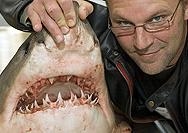Crash-testing carnivores
A research team featuring UNSW scientists will use sophisticated computer software to determine the "bite force" of a Great White Shark trapped off the central coast of N.S.W.
A research team featuring UNSW scientists will use sophisticated computer software to determine the "bite force" of a Great White Shark trapped off the central coast of N.S.W.

Scientists using sophisticated computer software will determine the "bite force" of a Great White Shark (Carcharodon carcharias) trapped off the central coast, north of Sydney, Australia.
The research will reveal unprecedented information about the creature's feeding habits by analysing new anatomical and biomechanical data from the shark's skull and muscle tissues.
The 2.4-metre male shark was recently imaged inside a computer tomography (CT) scanner that generated three-dimensional pictures of the shark's internal anatomy.
Using novel imaging and analysis software techniques developed by the research team from UNSW and Newcastle University, scientists have simplified the scan of the shark's skull, jaw and muscles into hundreds of thousands of tiny discrete, connected "finite elements".
Shaped like tiny three-dimensional triangular prisms (tetrahedrons) these elements contain a host of coded data about properties of the shark's tissue.
Using a technique called "finite element analysis" the researchers will be able effectively "crash test" the shark's skull and jaws under different scenarios inside a computer. This will reveal in new detail the complex set of structural and mechanical stresses and strains on the shark's skull anatomy and muscles.